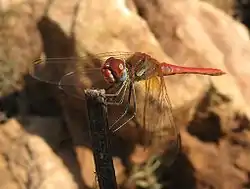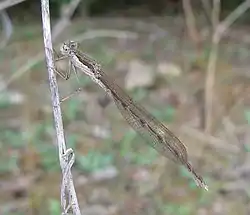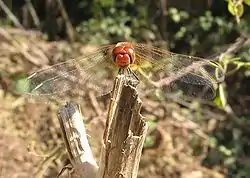List of dragonflies of Menorca
Menorca is a small island in the Mediterranean Sea belonging to Spain. Along with Majorca, Ibiza, and Formentera it is part of the Balearic Islands. It has a population of approximately 88,000. It is located 39°47' to 40°00'N, 3°52' to 4°24'E. It is a dry island without many wetlands or river systems; many of the wetlands in Menorca were drained to provide agricultural land. Despite this dragonflies are abundant on Menorca and in summer any pool of water will be alive with them. The best months to see dragonflies are May to September.

The taxonomy follows that of Dijkstra, K-D.B & Lewington, R. (2006).
Suborder Zygoptera (damselflies)

Family Calopterygidae (demoiselles)
- Calopteryx haemorrhoidalis, copper demoiselle - locally abundant in the right habitat
Family Lestidae (emerald damselflies or spreadwings)
- Sympecma fusca, winter damselfly - can be found in the winter months as S. fusca overwinters as an adult.
- Lestes viridis (Chalcolestes viridis), willow emerald damselfly - locally abundant
- Lestes barbarus, southern emerald damselfly - scarce
Family Coenagrionidae (blue, blue-tailed and red damselflies)
- Ischnura elegans, blue-tailed damselfly - common all over the island.
- Ceriagrion tenellum, small red damselfly - local
- Coenagrion caerulescens, Mediterranean bluet - rare
- Erythromma lindenii (Cercion lindenii), blue-eye, also called the goblet-marked damselfly.
Suborder Anisoptera (dragonflies)

Family Aeshnidae (hawkers and emperors)
- Aeshna affinis, blue-eyed hawker
- Aeshna mixta, migrant hawker
A. affinis and A. mixta are very alike in appearance. Blue aeshna are frequently seen in late summer but there are not many positive identifications of either species on record.
- Aeshna isoceles often put into the genus Anaciaeschna, green-eyed hawker - this species flies early in the year and is the only brown aeshna found on Menorca. Can be seen in the Algendar gorge.
- Anax imperator, emperor dragonfly also called blue emperor - common
- Anax parthenope, lesser emperor
Family Libellulidae (chasers, skimmers and darters)
- Libellula depressa, broad-bodied chaser
- Orthetrum cancellatum, black-tailed skimmer - fairly common
- Orthetrum coerulescens, keeled skimmer - fairly common
- Sympetrum striolatum, common darter - common
- Sympetrum fonscolombii, red-veined darter - common
- crocothemis erythraea, scarlet dragonfly or broad scarlet - fairly common
Most darters seen in Menorca with a very red colouring are S. fonscolombii but some are C. erythraea which occurs in many of the same locations. On close observation these two species can be told apart as they have quite different body shapes. Also S. fonscolombii usually oviposits in tandem whereas female C. erythraea oviposit solo.
See also
References
- Askew, R.R. (2004) The Dragonflies of Europe. (revised ed.) Harley Books. . ISBN 0-946589-75-5
- d'Aguilar, J., Dommanget, JL., and Prechac, R. (1986) A field guide to the Dragonflies of Britain, Europe and North Africa. Collins. . ISBN 0-00-219436-8
- Boudot JP., et al. (2009) Atlas of the Odonata of the Mediterranean and North Africa. Libellula Supplement 9:1-256.
- Dijkstra, K-D.B & Lewington, R. (2006) Field Guide to the Dragonflies of Britain and Europe. British Wildlife Publishing. ISBN 0-9531399-4-8.
- Ocharan, F.J., (1987) Neuvos datos sobre los odonatos de Menorca (Espana). Bol. R. Soc. Espanola Hist. Nat. (Biol.). 83 (1-4):155-161